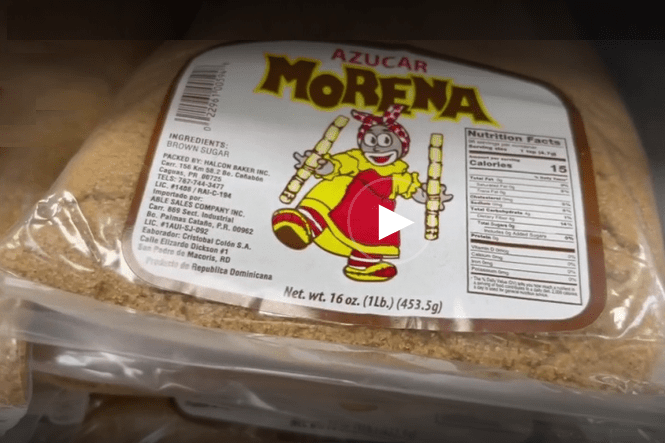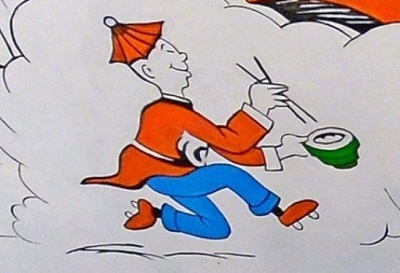In Margate, Florida…
…a controversy erupted in South Florida when a shopper at the Presidente Supermarket in Margate saw the logo on a package of Azucar Morena brown sugar (above). Paul Taffe, the indignant shopper, immediately reported to the local political correctness station—well, a local TV news squad—and expressed his horror.
“Doesn’t matter how you look at it, it’s racism in any form,” Taffe said. “Bottom line, and it should not be on the shelf. When you see an image of a Mammy dancing around with two sugar cane stalks in her hand, thinking that she’s having a jolly old time, it’s not. It was never a jolly old time for us.”
Not to be picky, but how does he know what “Mammy” is thinking? To be clear, like it or not, the fact of life in the U.S. is now that no cartoon representation of blacks is safe to present, unless the approach rejects the exaggeration of prominent features that makes it a cartoon as opposed to just a crude drawing. Exaggerated features on a white cartoon character…
…are recognized as humor and accepted as such; doing the same with any other race is racist, as with the sugar image above or Dr. Seuss’s now banned drawings…
The only politically correct option for a cartoonist is to draw other races exactly like he or she draws whites, and just color them differently. Whites, of course, can’t complain about how they are depicted, because if the picture is an exaggerated caricature, it’s just funny and doesn’t mean anything, and if it’s mean, well, they deserve it.
And, as Walter used to say, “That’s the way it is.” It’s foolish and a double standard; it essentially bans minorities from cartoons; it shows that whole segments of our society have crippling paranoia and inferiority complexes that impedes true societal integration, but denial isn’t a strategy for finding a solution. In a cultural environiment where Uncle Ben, Aunt Jemima and the Land ‘O Lakes girl are considered racist, of course the Azucar Morena brown sugar character isn’t acceptable to the outrage mobs.
Dr. Rokeshia Ashley, a Florida International University professor, was asked about the packaging and said, “I’m surprised that it’s on the shelf. I would think that in this day and age that some type of GM or some type of supermarket regulatory agency would be able to say, ‘Hey, what is this?” Oh, we are going to have regulatory agencies telling companies what are acceptable graphics now? Oh sure we are, if the types of people—you know, totalitarians—who teach at universities have their way….and don’t kid yourself, they might. The democratic way to police “cartoon ethics,” slanted as they are, is to let the market decide. If there are enough people like Paul Taffe, being stubborn about politically incorrect logos will result in lost profits, and the image will be cancelled. Paul has announced that he is boycotting both the store and the product.
One small note of irritation: the TV station’s website story on the episode says, “The woman on the label has darkened skin, a big smile, bright eyes, and hair tied up in a scarf.” She doesn’t have “darkened skin,” which suggests blackface. She has dark skin. The same story describes the image as a “Mammy.” Hattie McDaniel in “Gone With The Wind” was not in blackface. She used her own face.



What is interesting is that the product is from the Dominican Republic and packaged and exported from Puerto Rico. I doubt seriously if any Whitey’s had a hand in the package’s graphics. And even if they did the onus lies with the Puerto Rican management of the firm.
Exactly, Chris.
I was wondering, though: doesn’t this story show the disconnect with the Outragers? Aren’t they imposing their concepts of race, white supremacy, US superiority and hegemony on other countries? Do they think the Dominican Republic, Puerto Rico, Guam, and/or the Lesser Antilles should accept what the NAACP, the Congressional Black Caucus, antifa, the Proud Boys and the Klan dictate about race and race relations here in the US?
jvb
Yeah, I saw that. Had no idea white racists had such a foothold in the DR. Wonder if they’re running things in Haiti too?
Oddly enough, yes (for certain values of “white”), and it has been that way for generations. There has long been a certain amount of border tension between Haiti and the Dominican Republic, the two countries on the island of Hispaniola. It has sometimes risen to the level of border disputes or even more, but usually it shows up as leaks of migrants from Haiti over the porous border (that may ring bells with some readers). For historical reasons, Haiti is nearly completely populated by people of sub-saharan African ancestry, while the Dominican Republic has a material proportion of ancestry from the Iberian Peninsula and some of indigenous ancestry, and the former country is the poorer of the two (again, for historical reasons). Even though the Dominican Republic is not populated by “whites” by the standards of many times and places, whiteness has become a point of differentiation for them, allowing them to treat their illegal immigration problem as a problem caused by the “other”.
Thank you, P.M., for that excellent comment with a needed clarification of this situation. More generally, a number of other countries in our hemisphere have an internal social issue known as “colorism” which everyone can look up.
By any standard that now obtains anywhere in the United States, the illustration on that package of brown sugar is plainly offensive and Mr. Taffe’s complaint is eminently understandable. No, I don’t think a “supermarket regulatory agency” should be involved, but there’s a supply chain involved here and a management failure has taken place somewhere along the way. It makes perfect sense that it’s being publicized.
Freedom’s just another word for someone telling you must do.
Or maybe “Freedom’s just another word for nothing left to choose.” ? 😉
In a used book store, I recently picked up a large format anthology of 13 “best loved” Dr. Seuss stories, 2014 copyright, to add to the library in the “grandkids’ room”. Ironically, the first three stories are the ones now “banned”.
It made me sad, though. An end paper inscription indicated that the book was a 2018 Christmas gift from a grandparent to a grandchild. Other than that, the book was pristine, with no evidence that it had ever been read, or even been opened and laid flat enough to crease the spine. I’ll make sure that changes with our littles.
“On Beyond Zebra” and “If I ran the Zoo” were (and are) my favorite Dr. Seuss books.
The darn books are selling for $100’s on Ebay/Amazon, proving this is not a free-market decision to retract them. I’ve complained that I can’t even review them to see why they are controversial, and have been told to just read pirated copies online.
I told them it was cute that they advised me to violate copyright to get around censorship.
My shopping list going to the supermarket includes”white bread,” red and yellow peppers, green tomatoes, dark chocolate milk, and black licorice. should i be trembling in fear for the supermarket supervisory language police?
No no, you’re good since you didn’t have “THE” anywhere on your shopping list.
–Dwayne